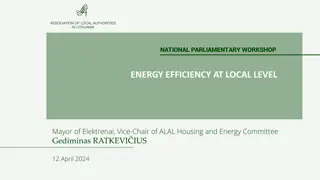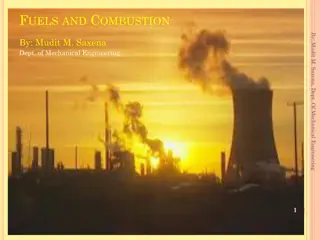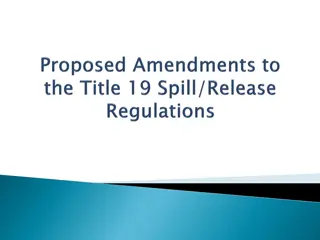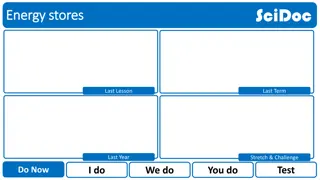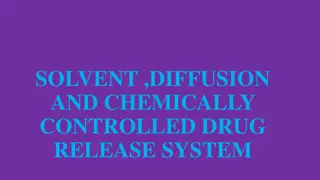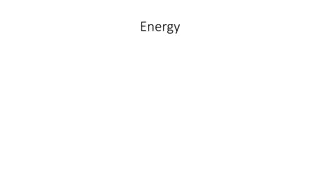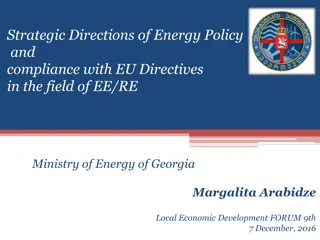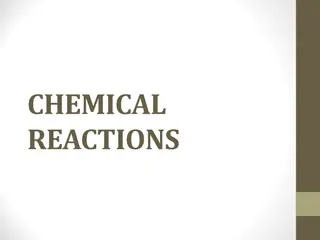When I Use a Word - Calorific Value and Energy Release
In this content, Lewis Carroll's quote on word meanings is juxtaposed with information on calorific value, energy release, and combustion reactions. It covers the differences between Higher and Lower Calorific Values, the recovery of latent heat in modern systems, and the significance of Calorific Values in the energy sector. The content provides insights into anaerobic digestion of microalgae and the sustainable production of microalgal biodiesel. Additionally, it explains the calorific value of methane and the enthalpy of water, shedding light on the complexities of energy transformation processes.
Uploaded on Feb 28, 2025 | 0 Views
Download Presentation

Please find below an Image/Link to download the presentation.
The content on the website is provided AS IS for your information and personal use only. It may not be sold, licensed, or shared on other websites without obtaining consent from the author.If you encounter any issues during the download, it is possible that the publisher has removed the file from their server.
You are allowed to download the files provided on this website for personal or commercial use, subject to the condition that they are used lawfully. All files are the property of their respective owners.
The content on the website is provided AS IS for your information and personal use only. It may not be sold, licensed, or shared on other websites without obtaining consent from the author.
E N D
Presentation Transcript
When I use a word, it means just what I choose it to mean neither more nor less LEWIS CARROLL , Through the Looking-Glass,
35.6kJ L-1 SIALVE, B., BERNET, N. & BERNARD, O. 2009. Anaerobic digestion of microalgae as a necessary step to make microalgal biodiesel sustainable. J.Biotech adv, 27, 409-16
Calorific Value of Methane John J Milledge
A Simple Reaction CH4 + 2O2 = CO2 + 2H2O What is the problem?
Calorific Value; Higher or Lower ? Heat of Combustion The calorific value of a fuel is the energy released by a unit quantity of fuel on complete combustion. Higher Calorific Value (Gross) is the value obtained when all the water vapour has been condensed EASTOP, T. D. & MCCONKEY, A. 1970. Applied Thermodynamics for Engineering Technologists, New York, Longman.
Lower Calorific Value (Net) assumes all the water from the reaction remains as water vapour. Enthalpy Water Hliquid= 285.83kJ mol-1 Hgas =241.83kJ mol-1 Energy released on condensation = 44kJ mol-1 2 moles of H2O are generated from the combustion of 1mole of CH4 Difference between HCV & LCV 88kJ mol-1 NIST Standard Reference Data . http://webbook.nist.gov/cgi/cbook.cgi?ID=C7732185&Units=SI&Mask=1#Thermo-Gas
Lower Calorific Value In older boiler systems the latent heat from the condensation of water vapour was not recovered.
Modern Systems attempt to recover the latent energy of water vapour
Higher Calorific Value Higher Calorific Value is widely used by the Department of Energy and Climate Change and UK National Statistics. http://www.statistics.gov.uk/hub/business-energy/energy/energy-prices
Food. Calorific Value Protein is incompletely oxidised in the body . Nitrogen together with some carbon and hydrogen leave the body mainly in form of urea. 1.25 kcal are often deducted from the heat of combustion of protein for un-oxidised products excreted in urine Total Nitrogen is often used to calculate protein. MERRILL, A. L. & WATTS, B. K. 1955. Energy values of foods: Basis & Duration. Slight revised February 1973. US Department of Agriculture. Available on line at http://www.nal.usda.gov/fnic/foodcomp/Data/Classics/ah74.pdf
Methane Heat of Combustion per Mole HCV cH gas -890.16 to -891.8kJ mol-1 NIST Standard Reference Data. http://webbook.nist.gov/cgi/cbook.cgi?ID=C74828&Mask=1#Thermo-Gas ( cH gas -212.8 kcal mol-1 @25 C cH gas - 891.0 kJ mol-1 cH gas - 890.63 kJ mol-1 @25 C cH gas - 892.97 kJ mol-1 @0 C BSI 2005. Natural gas - Calculation of calorific values, density, relative density & Wobbe index from composition. BS EN ISO 6976:2005. kilocalorie = 4.1868kJ PERRY, R. H. & CHILTON, C. H. 1973. Chemical Engineers' Handbook, Tokyo, McGraw Hill. GLASSTONE, S. & LEWIS, D. 1970. Elements of Physical Chemistry, London, MacMillan. (
Enthalpy Calculation Energy release = Enthalpy of the products less Enthalpy of reactants CH4(g) + 2O2(g) = CO2(g) + 2H2O(l) CO2(g) 2H2O(l) ( 2 x 68.31) CH4(g) 2O2(g) Heat of Combustion (891.33kJ/mole) -212.89 kcal mol-1 NIST Standard Reference Data. http://webbook.nist.gov/cgi/cbook.cgi?ID=C74828&Mask=1#Thermo-Gas 298.15 K 1bar -94.05 -136.64 17.80 0.0
Bond Energy Calculation CH4 + 2O2 = CO2 + 2H2O Reactants C-H 98 O=O 118 Products C=O(CO2) 192 O-H 110 Lower Calorific Value (Exothermic) (25 C) GLASSTONE, S. & LEWIS, D. 1970. Elements of Physical Chemistry, London, MacMillan. Michigan State University. http://www2.chemistry.msu.edu/faculty/reusch/VirtTxtJml/react2.htm CH4 =98 x 4 2O2 = 2 x 118 392 236 628 CO2 = 192x 2 2H2O = 110 x 4 384 440 824 -196Kcal/mole
Bond Energies are average bond enthalpies for the gaseous state Difference between HCV & LCV 88kJ mol-1 21.2 kcal mol-1 Calculated HCV from bond energy= 196 + 21.2 = 217.2 kcal mol-1 (909.4kJ mol-1)
Temperature & Pressure Boyle s law; The volume of a gas varies inversely with its pressure at constant temperature Charles Law (Gay- Lussac s Law); The volume of a gas at constant pressure varies in direct proportion to the absolute temperature. Avogadro s Law; Equal numbers of molecules of different gases will occupy the same volume at a given temperature and pressure.
Ideal Gas Law PV = nRT P, V and T are the pressure, volume and absolute temperature. n is the number of moles of gas R is the universal gas constant . I mole of gas occupies 22.414L at STP (273.15 K at 1 atmosphere) R is 0.082 litre atmosphere per mole per degree Kelvin R is the universal gas constant . I mole of gas occupies 22.71108L at STP (273.15 K at 1 bar) R is 8.314472 J K-1 mol-1 GLASSTONE, S. & LEWIS, D. 1970. Elements of Physical Chemistry, London, MacMillan. SAWYER, C. N. & MCCARTY, P. L. 1967. Chemistry for Sanitary Engineers, New York, McGraw Hill. http://www.iupac.org/publications/books/gbook/green_book_2ed.pdf
Ideal Gas No Gas behaves ideally Fortunately all gases approach ideal behave as pressure decreases
Real Gas For the purposes of the International Standard (BS EN ISO 6976:2005) the real-gas calorific value on a molar basis is taken as numerically equal to the corresponding ideal-gas value. NOTE In practice, this correction is very small for typical natural gases, and can usually be neglected with resultant errors approximately 0.005 % BSI 2005. Natural gas - Calculation of calorific values, density, relative density & Wobbe index from composition. BS EN ISO 6976:2005
Standard Temperature & Pressure When gas volumes are reported as corrected to standard temperature and pressure (STP), more often than not the standard conditions are not given. There are currently several definitions of STP in widespread use, with standard temperatures between 0 and 25 C and standard pressures between 100 and 101.325 kPa, quoted in a variety of units. As an extreme example, using the former International Union of Pure and Applied Chemistry definition of 0 C and 101.325 and the National Bureau of Standards definition of 25 C and 100 kPa gives a volume difference of more than 10% for the same mass of gas. WALKER, M., ZHANG, Y., HEAVEN, S. & BANKS, C. 2009. Potential errors in the quantitative evaluation of biogas production in anaerobic digestion processes. Bioresource Technology, 100, 6339-6346.
Gas Metering Temperatures T1 0 20 25 15 15 T2 0 20 0 15 15 Japan China Germany United Kingdom USA T1/ C = combustion reference temperature T2/ C = volumetric or metering reference temperature The reference pressure is 101,325 kPa in all cases BSI 2005. Natural gas - standard reference conditions. BS EN ISO 13443:2005.
Gas Production Temperature Mesophilic digestion Thermophilic digestion 35.6kJ L-1 HCV at 35 C
Standard Temperature Pressure Oxford Dictionary Science Definition STP Standard Temperature Pressure formerly known as NTP (Normal Temperature and Pressure). The standard conditions used as a basis for calculations involving quantities that vary with temperature and pressure. These conditions are used when comparing the properties of gases. They are 273.15 K (0 C) and 101325Pa (or 760mmHg) DAINTITH, J. & MARTIN, E. (eds.) 2010. A Dictionary of Science Oxford Oxford University Press
Standard Pressure STP of 0 C (273.15 K) and 101.325 kPa is the old IUPAC standard http://old.iupac.org/goldbook/ http://www.iupac.org/goldbook/S05910.pdf IUPAC recommends that the former use of the pressure of 1 atm as standard pressure (equivalent to 1.01325 x 105 Pa) should be discontinued and now suggests a pressure for STP 105 pascals (1bar)
BS & ISO Standard Pressure A Pressure of 101.325 kPa (1 atmosphere) is widely used in ISO standards and in particular those concerned with Natural Gas and Methane. BSI 2005a. Natural gas - Calculation of calorific values, density, relative density & Wobbe index from composition. BS EN ISO 6976:2005. BSI 2005b. Natural gas - standard reference conditions. BS EN ISO 13443:2005.
Joules Law The internal energy of a ideal gas is a function of absolute temperature only. At any constant temperature the internal energy is independent of its volume. H = U + pV if U constant H = p V = (101325-100000)(0.022413996-0.0 2271108 ) 0.4 Joules Although Methane, is not an ideal gas the change in heat of combustion per mole between the two suggested standard pressure is very small less than 1 joule per mole
Higher Calorific Value of Methane Courtesy of Sonia Heaven MJ kg-1 g mol-1 Mol litre-1 MJ m-3 CH4 H2 55.662 141.79 16.04 2.01588 22.414 22.414 39.84 12.75 C H CH4 12.011 1.00794 16.04276 0.715747g CH4 l-1 CV from BS EN ISO 6975 at 0 C on a mass basis Weiser, M.E. (2007) Atomic Weights of the Elements 2005. J. Physical and Chemical Reference Data 36, 485 (2007); doi:10.1063/1.2717223 22.413 996(39) 10-3 m3 mol-1 with relative standard uncertainty 1.7 10-6, at 273.15 K and 101.325 kPa Mohr, P.J., Taylor, B.N., Newell, D.B. (2008) CODATA Recommended Values of the Fundamental Physical Constants: 2006. Reviews of Modern Physics 80: 633 730
Begin at the beginning and go on till you come to the end: then stop. LEWIS CARROLL, Alice in Wonderland






